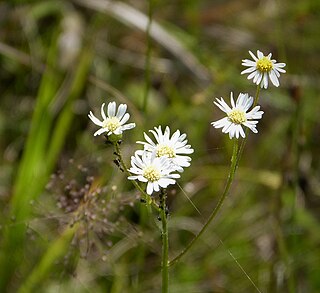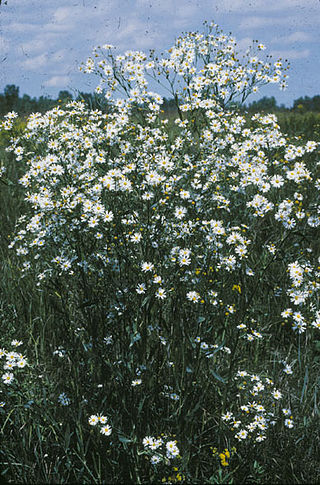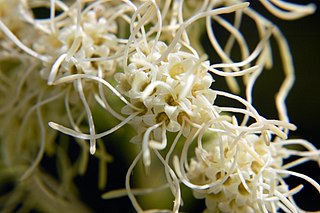
Rudbeckia hirta, commonly called black-eyed Susan, is a North American flowering plant in the family Asteraceae, native to Eastern and Central North America and naturalized in the Western part of the continent as well as in China. It has now been found in all 10 Canadian Provinces and all 48 of the states in the contiguous United States.

Plains coreopsis, garden tickseed, golden tickseed, or calliopsis, Coreopsis tinctoria, is an annual forb. The plant is common in Canada, northeast Mexico, and much of the United States, especially the Great Plains and Southern states where it is often called "calliopsis." The species is also widely cultivated and naturalized in China.

Cirsium edule, the edible thistle or Indian thistle, is a species of thistle in the genus Cirsium, native to western North America from southeastern Alaska south through British Columbia to Washington and Oregon, and locally inland to Idaho. It is a larval host to the mylitta crescent and the painted lady.

Rudbeckia fulgida, the orange coneflower or perennial coneflower, is a species of flowering plant in the family Asteraceae, native to eastern North America.

Boltonia diffusa, the smallhead doll's daisy, is a North American species of plants in the family Asteraceae. It native to the United States, primarily the states along the Gulf of Mexico from Texas to Florida plus the lower Mississippi Valley from Louisiana to Illinois. There additional populations in the eastern United States as far north as Virginia.

Chrysogonum virginianum, the golden-knee, green and gold, or goldenstar, is a North American species of plants in the family Asteraceae. It is native to the eastern United States from New York State and Rhode Island south to Louisiana and the Florida Panhandle.

Anaphalis margaritacea, commonly known as the western pearly everlasting or pearly everlasting, is an Asian and North American species of flowering perennial plant in the family Asteraceae.

Boltonia is a genus of plants in the family Asteraceae native primarily to North America with one species in eastern Asia.

Agoseris aurantiaca is a species of plant in the family Asteraceae, commonly called orange agoseris or mountain dandelion. It is widespread in western North America.

Boltonia decurrens is a rare species of flowering plant in the family Asteraceae known by the common names decurrent false aster and claspingleaf doll's daisy. It is native to the floodplains along the Illinois and Mississippi Rivers in the United States, where the habitat has been drastically altered, leading to its decline. The plant was once distributed across 400 kilometers of riverside forest from LaSalle, Illinois, to St. Louis, Missouri. As the rivers and riparian habitat alongside them have been developed, the plant's distribution has been fragmented into about 20 separate populations, mostly in Illinois. At one point it was thought to have been extirpated from Missouri, but a few populations have been located near St. Louis since the mid-1980s. Despite having declined over time, several populations of the plant contain many thousands of individuals. Populations vary depending on the amount and duration of flooding that occurs in the area each year. The plant is a federally listed threatened species.

Heliopsis helianthoides is a species of flowering plant in the family Asteraceae, known by the common names rough oxeye, smooth oxeye and false sunflower. It is native to eastern and central North America from Saskatchewan east to Newfoundland and south as far as Texas, New Mexico, and Georgia.

Helianthus decapetalus, known by the common names thinleaf sunflower and thin-leaved sunflower, is a perennial forb in the family Asteraceae. It is native to the Eastern and Central United States and Canada, from New Brunswick west to Iowa, Wisconsin, and Ontario, south as far as Georgia and Louisiana. It produces yellow composite flowers in late summer or early fall.

Sagittaria graminea, the grassy arrowhead or grass-leaved arrowhead, is an aquatic plant species native to eastern North America.
Boltonia caroliniana, common name Carolina doll's-daisy, is a North American species of plants in the family Asteraceae. It is found only in the southeastern United States, primarily in the states of North Carolina, South Carolina, and Virginia with a few isolated populations in western Georgia.

Bradburia pilosa, the soft goldenaster, is a North American species of flowering plants in the family Asteraceae, native to the south-central United States, primarily the southeastern Great Plains and lower Mississippi Valley, in the states of Texas, Oklahoma, Kansas, Missouri, Arkansas, Louisiana, Tennessee, Mississippi, and Alabama. Additional populations are reported farther east but these appear to be introductions. Its habitats include disturbed roadsides and pine-oak-juniper woods.

Brickellia eupatorioides, or false boneset, is a North American species of flowering plants in the family Asteraceae. It is widespread in Mexico from Chihuahua to Oaxaca, and in all regions of the contiguous United States except New England, New York, and the West Coast.
Cirsium pumilum, the pasture thistle, is a North American species of plants in the tribe Cardueae within the family Asteraceae. The species is native to the northeastern and north-central United States as well as to the Canadian Province of Ontario.
Erigeron bellidiastrum, the western daisy fleabane or sand fleabane, is a species of fleabane in the family Asteraceae. It is native to northern Mexico and the western and central United States.

Erigeron poliospermus is a species of flowering plant in the family Asteraceae known by the common names gray-seeded fleabane and purple cushion fleabane. Native to western North America, it is mainly found to the east of the Cascade Range in Washington, Oregon, and Idaho.
Lactuca ludoviciana, the biannual lettuce, is a North American species of wild lettuce. It is widespread across much of central and western Canada and the western and central United States from Ontario west to British Columbia and south to Louisiana, Texas, and California. Most of the known populations are on the Great Plains; populations west of there may well represent naturalizations.
















